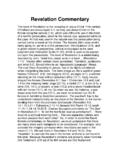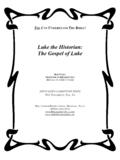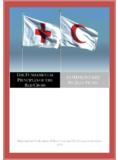Transcription of American Chiropractic Association Commentary on …
1 American Chiropractic Association Commentary on Centers for Medicare and Medicaid Services (CMS)/PART Clinical Documentation Guidelines 2 DISCLAIMER The American Chiropractic Association provides this Commentary in order to assist its members to better understand the Medicare PART clinical documentation guidelines. These are Centers for Medicare and Medicaid Services (CMS) guidelines that apply to Medicare only. CMS guidelines are not endorsed or approved by the ACA and this Commentary is provided only for informational assistance and is strictly advisory in nature. The ACA recommends that you direct inquiries to your local Medicare carrier regarding any questions about CMS guidelines and this Commentary does not take precedence over any federal regulation or directive.
2 The ACA will take no action to enforce or otherwise require member compliance with this Commentary . ACA reserves the right to lobby governmental entities to revise or rescind any portion of the described documentation guidelines. 3 Documenting Medical Necessity for Medicare Integrating PART to Ensure Compliance Under the policies developed by the Centers for Medicare and Medicaid Services (CMS), coverage of Chiropractic services is specifically limited to manual manipulation of the spine to correct a subluxation. Unless this subluxation is properly documented, medical necessity has not been established and claims may be rejected by Medicare. In this piece, we will review the documentation guidelines CMS has established. We will help identify what the carriers are looking for, when they want it, and where the documentation must appear.
3 Utilization guidelines for Chiropractic services require the following three components in order to establish medical necessity: 1 Presence of a subluxation that causes a significant neuromusculoskeletal condition. Medicare will not pay for treatment unless it is by manual manipulation of the spine to correct a subluxation. The subluxation must be consistent with the complaint/condition. 2 Documentation of the Subluxation A subluxation may be demonstrated by one of two methods: x-ray or physical examination. If documented by physical examination, the PART system (as described below) must be used. 3 Documentation of the Initial and Subsequent Visits Specific documentation requirements apply whether the subluxation is demonstrated by x-ray or by physical examination. PRESENCE OF A SUBLUXATION The subluxation is defined as a motion segment in which alignment, movement integrity, and/or physiological function of the spine are altered although contact between joint surfaces remains intact.
4 Medicare will not pay for treatment unless it is manual manipulation of the spine to correct a subluxation. Therefore, you must document in your patient s physical examination, their initial chart notes, and subsequent chart notes that you are indeed treating a subluxation. Most Medicare carriers require that the primary diagnosis reported on the CMS-1500 form is subluxation. Some carriers require the use of 839 level ICD-9 diagnosis codes and others require the use of 739 series ICD-9 diagnosis codes to describe the subluxation. Check your carrier s Local Medicare Review Policy (LMRP) to be sure which diagnosis is required. DOCUMENTATION OF THE SUBLUXATION: The PART System One of the hottest topics for chiropractors over recent months has been the PART documentation system for Medicare.
5 Recall that the subluxation may be documented by one of two methods: x-ray or physical examination, and that if the latter is used it must be documented according to the PART system. The four components of PART are described below. HCFA requires that at least two of the four components must be documented, and at least one of A or R. 4 PAIN AND TENDERNESS Identify using one or more of the following: Observation: You can document, by personal observation, the pain that the patient exhibits during the course of the examination. Note the location, quality, and severity of the pain Percussion, Palpation, or Provocation: When examining the patient, ask them if pain is reproduced, such as, Let me know if any of this causes discomfort. Visual Analog Type Scale: The patient is asked to grade the pain on a visual analog type scale from 0-10.
6 Audio Confirmation: Like the visual analog scale, the patient is asked to verbally grade their pain from 0-10. Pain questionnaires: Patient questionnaires, such as the McGill pain questionnaire or an in-office patient history form, can be used for the patient to describe their pain. ASYMMETRY/MISALIGNMENT Identify on a sectional or segmental level by using one or more of the following: Observation: You can observe patient posture or analyze gait. Static and Dynamic Palpation: Describe the spinal misaligned vertebrae and symmetry. Diagnostic Imaging: You can use x-ray, CAT scan and MRI to identify misalignments. RANGE OF MOTION ABNORMALITY Identify an increase or decrease in segmental mobility using one or more of the following: Observation: You can observe an increase or decrease in the patient s range of motion.
7 Motion Palpation: You can record your palpation findings, including listing(s). Be sure to record the various areas that are involved and related to the regions manipulated. Stress Diagnostic Imaging: You can x-ray the patient using bending views. Range of Motion Measuring Devices: Devices such as goniometers or inclinometers can be used to record specific measurements. TISSUE, TONE CHANGES Identify using one or more of the following Observation: Visible changes such as signs of spasm, inflammation, swelling, rigidity, etc. Palpation: Palpated changes in the tissue, such as hypertonicity, hypotonicity, spasm, inflammation, tautness, rigidity, flaccidity, etc. can be found on palpation. Use of instrumentation: Document the instrument used and findings. Tests for Length and Strength: Document leg length, scoliosis contracture, and strength of muscles that relate.
8 The above descriptions must be included in your patient s record. No specific national policy exists on when you should send your records to your carrier. Individual carriers may specify what they want, and when, but as a matter of rule only the CMS-1500 form is submitted. Because of this, it is vital that all appropriate boxes on the CMS-1500 are filled in completely and accurately for each billing submitted since the CMS 1500 claims form is considered a necessary part of the documentation requirements. The carrier may request patient records at times, so it is just as important to keep standardized patient chart notes. PART 5 DOCUMENTATION OF THE INITIAL AND SUBSEQUENT VISITS As you already know, CMS has established specific requirements for documentation of both initial and subsequent office visits.
9 Before we integrate PART, let s review these requirements: Initial Visit Requirements Relevant History of Patient s Condition with Detailed Description of the Present Condition Evaluation of Musculoskeletal/Nervous System Through Physical Examination Diagnosis Treatment Plan Recommended level of care (duration and frequency of visits) Specific treatment goals Objective measures to evaluate treatment effectiveness Date of Initial Treatment Subsequent Visit Requirements History Review of chief complaint Improvement or regression since last visit System review, if relevant. Physical Examination CMS states that the following requirements should be included in your patient chart notes to describe the presenting complaint. After completing your case history with the patient, you should be able to ask yourself the questions below and answer them with your documentation: Requirement Ask Yourself Symptoms causing the patient to seek treatment Why is patient seeking care?
10 Mechanism of onset How did the condition/injury happen? Gradual/sudden? Quality and character of symptoms/problem Onset, duration, intensity, frequency, location, and radiation of symptoms Do my notes paint a picture of the patient s symptoms, including specific descriptive remarks that would allow a third-party reader to fully understand this complaint? Aggravating or relieving factors What causes the condition to improve or worsen? Prior interventions, treatments, medications, secondary complaint What has been tried in the past and are there any complicating factors? Family history, if relevant Are there any factors in the family history that relate to this condition? Past health history (general health, prior illness, injuries, hospitalizations, medication, surgical history) What aspects of the patient s health history factor into this current condition?












